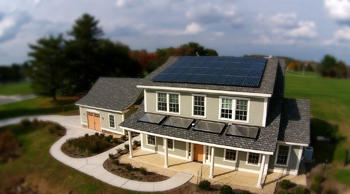New Publications Scope Future Research, Detail Design and Operation of NIST's Net-Zero Energy House

The NIST Net-Zero Energy Residential Test Facility in Gaithersburg, Md.
The National Institute of Standards and Technology (NIST) recently interviewed engineers, architects, builders and other experts for ideas on research to pursue following the successful debut of its Net-Zero Energy Residential Test Facility (NZERTF). It got the equivalent of a house filled to the rafters with recommendations—almost 200 suggested topics spanning 34 categories.
Summarized in a new publication*, the recommended research and development opportunities range from practical tests for assessing the airtightness of building enclosures to questions about measuring indoor air quality to dynamic control strategies that take full advantage of emerging "smart grid" capabilities.
In addition, NIST recently published two other companion publications pertaining to its unique test house. One presents the principles that guided the design of the net-zero energy house**, the other details the key monitoring and measuring systems installed in the NZERTF***.
"This thoughtful and useful guidance will serve as a critical resource for current and future NZERTF researchers," says Hunter Fanney, the NIST senior research scientist who leads the NZERT team. "It also will serve as a useful starting point for forging research partnerships to speed progress toward more energy-efficient residential buildings that are of high quality and meet the everyday needs of occupants."
The NZERTF is a laboratory doubling as a prototypical suburban home on the NIST campus in Gaithersburg, Md. Typical in appearance to new suburban single-family dwellings, the two-story, four-bedroom, three-bath house incorporates energy-efficient construction and appliances, as well as energy-generating technologies such as solar water heating and solar photovoltaic systems.
On July 1, 2014, the NZERTF house completed a successful year-long demonstration, generating more energy than the house and its virtual family of four consumed over the entire 12-month span. Now, NIST researchers and their collaborators are transitioning the house to accomplish its chief objective: developing improved or new test methods and performance metrics for energy-efficient building technologies and renewable-energy systems.
To help them craft a research agenda responsive to the needs and priorities of the building industry, regulators, standards organizations, and others, the NZERTF team surveyed building, technology, and energy-efficiency experts from 22 companies, universities, trade and professional associations, and state and federal agencies.
Research questions and issues span a diverse range, from windows and plumbing systems to whole-house commissioning performance testing. Other topics identified for study at the NZERTF include envelope design; site considerations; heating, ventilation and air conditioning systems; air distribution systems; renewable energy technologies; control systems; fault detection and diagnostics; indoor environmental quality; and methods for managing and communicating energy-usage information.
* P.D. Domich, B. Pettit, A.H. Fanney and W.M. Healy. Research and Development Opportunities for the NIST Net-Zero Energy
Residential Test Facility, NIST Technical Note 1869, March 2015.
** B. Pettit, C. Gates, A.H. Fanney and W.M. Healy. Design Challenges of the NIST Net-Zero Energy Residential Test Facility, NIST Technical Note 1847, Dec. 2014.
*** M.W. Davis. W.M. Healy, M.T. Boyd, L.C. Ng; W.V. Payne, H. M. Skye and Tania Ullah. Monitoring Techniques for the Net-Zero Energy Residential Test Facility, NIST Technical Note 1854, Dec. 2014.

